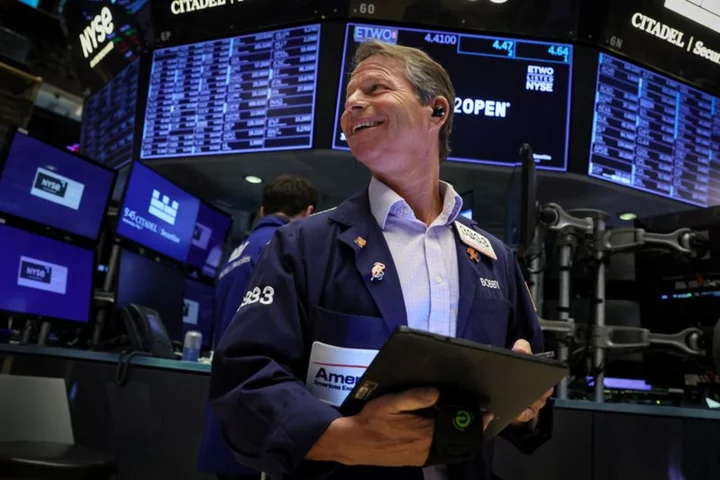By Lewis Krauskopf
NEW YORK Worries that have dogged U.S. stocks for months are fading, pushing some Wall Street firms to raise their outlooks for equities and beckoning investors who have remained on the sidelines.
Signs of strength in the economy, relief over a deal to raise the U.S. debt ceiling and an interest rate hiking cycle that may be nearing its end have heartened investors and driven the benchmark S&P 500 up nearly 20% from its October low - one definition of a bull market.
Further gains may hinge on whether investors who cut stock allocations to the bone over the last year return to the market. Cash on the sidelines is plentiful: U.S. money market fund assets hit a new record of $5.8 trillion last month, while cash levels among global fund managers remain high relative to history, according to the latest survey from BofA Global Research.
And while computer-driven strategies have been piling into the market for months, according to Deutsche Bank, positioning among discretionary investors -- a cohort that includes everyone from active mutual funds to retail investors -- is lighter than it has been 74% of the time since 2010, the bank’s data showed.
"There certainly seems to be a bit of a more optimistic ring to the market," said Chuck Carlson, chief executive officer at Horizon Investment Services. "Further strength might beget further strength because of the FOMO factor," he added, using the popular acronym for "fear of missing out."
DISSIPATING RISKS
A stronger-than-expected U.S. economy is one reason for investor optimism, after many spent months girding for a widely expected recession.
Data on Friday showed U.S. job growth accelerated in May, even as the unemployment rate rose to a seven-month high – bolstering the case for those betting the Fed can contain inflation without badly damaging growth.
"Inflation has clearly subsided, and yet labor market strength has remained intact," wrote BMO Capital Markets chief investment strategist Brian Belski in a recent note. While a severe recession was his biggest worry at the start of the year, now “the anticipated recipe for disaster is simply not present.” BMO raised its year-end S&P 500 price target to 4,550 from 4,300. The index, which is up 11% year-to-date, closed at 4,267.52 on Wednesday. It is up 19.3% since Oct 12.
Other firms that have issued rosy targets in recent days include Evercore ISI, which now sees the S&P 500 at 4,450 at year end, up from its prior view of 4,150, and Stifel, which anticipates the index will reach 4,400 by the third quarter. BofA late last month raised its year-end target for the index to 4,300 from 4,000.
Another key risk dissipated last week when Congress passed a bill to suspend the debt ceiling, averting a potentially catastrophic U.S. default. “Moving past the debt ceiling and at least having some economic data that looks ok is actually enough to get some people interested,” said Keith Lerner, co-chief investment officer at Truist Advisory Services. Lerner on Monday shifted his expected S&P 500 range for this year up to 3,800-4,500, from 3,400-4,300 previously, citing improving earnings trends among other factors. At the same time, investors have been cheered by signals that the Fed is unlikely to deliver many more of the rate increases that shook markets over the last year. Bets in futures markets showed investors projecting the Fed would leave rates unchanged at its June 13-14 monetary policy meeting and raise them only once more this year.
Of course, plenty of skeptics remain. John Lynch, chief investment officer for Comerica Wealth Management, said the S&P 500 could retest its October lows with "elevated interest rates and tighter credit standards weighing on economic activity for the remainder of the year." Another worrisome signal is the fact that the S&P 500's gain this year has been spurred by just a handful of megacap stocks like Microsoft and Nvidia, which have been fueled in part by excitement over advances in artificial intelligence, while large areas of the market have languished. For Hans Olsen, chief investment officer at Fiduciary Trust Co, that’s an ominous sign. Olsen believes signals such as the inverted yield curve show recession risks remain “pretty high” and his firm is maintaining higher than typical cash levels. “We have one powerful rally inside a bear market that has yet to be fully resolved,” he said.
(Reporting by Lewis Krauskopf; Editing by Ira Iosebashvili and Diane Craft)

